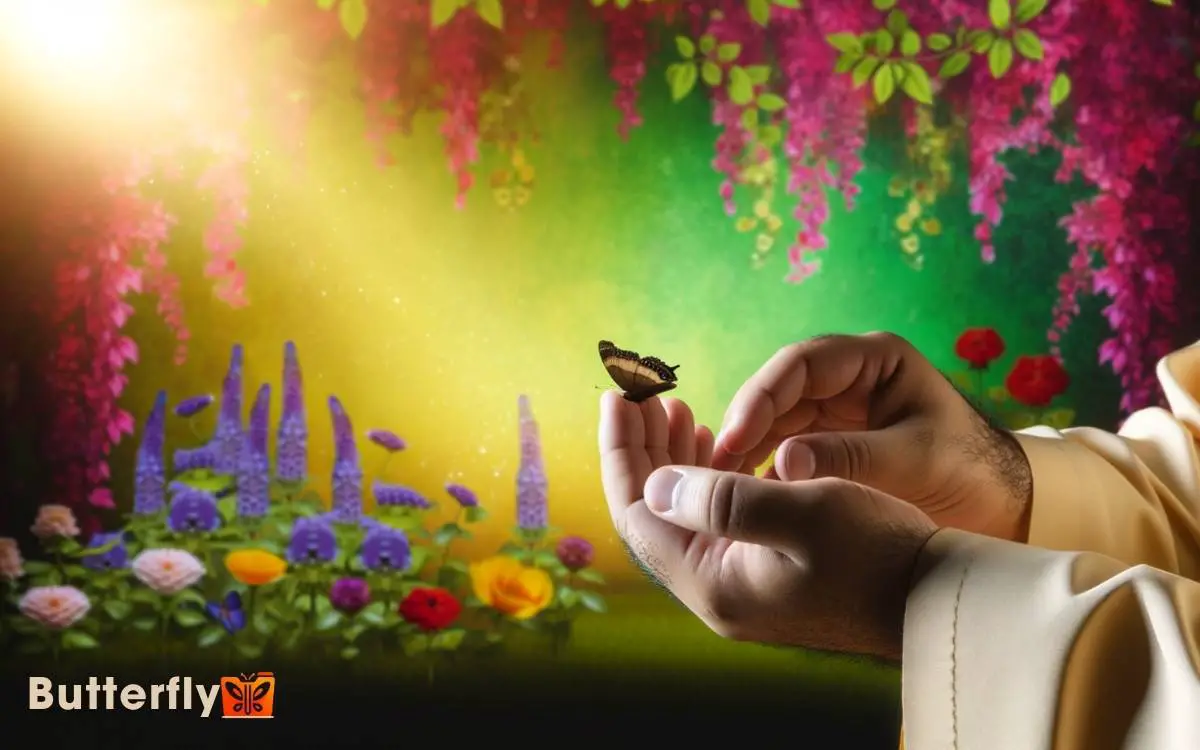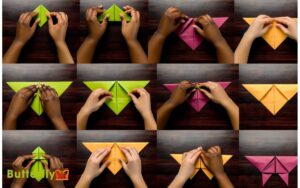How To Help An Injured Butterfly? A Care Guide!
When you find an injured butterfly, first identify common injuries such as torn wings, bent antennae, or twisted legs using good lighting and a magnifying tool.
Prepare a detailed container with fresh leaves, twigs, and diluted honey or sugar water to simulate their natural environment. Handle the butterfly gently, gripping the wings’ edges and thorax carefully.
Assess the damage meticulously, then nourish them with a clean feeding area to prevent bacterial growth.
Monitor their recovery by observing wing movement, feeding behavior, and overall stability. For detailed guidance on each step, explore the thorough instructions provided.

Key Takeaways
Identifying Common Injuries
When identifying common injuries in butterflies, you should look for torn wings, damaged antennae, and impaired legs. Torn wings often present as irregular edges or missing sections, impairing flight capability.
Damaged antennae, critical for navigation and sensory perception, may appear bent or broken. Legs, essential for landing and feeding, can be visibly twisted or missing segments.
Examine the butterfly in a well-lit area, using a magnifying tool for precise observation. Note any discoloration or unusual behaviors such as difficulty in flying or clinging to surfaces.
Early detection of these injuries can greatly improve the chances of successful rehabilitation, allowing you to apply innovative solutions for their recovery. Always handle with care to prevent additional harm.
Preparing a Safe Space
To guarantee a butterfly’s recovery, set up a controlled, secure environment that mimics its natural habitat. Use a ventilated container, such as a mesh cage, ensuring ample airflow. Line the bottom with fresh leaves, providing a natural substrate.
Include twigs or small branches for perching, facilitating natural behaviors. Maintain a stable temperature around 75°F (24°C) and moderate humidity, roughly 60%.
Place a shallow dish with diluted honey or sugar water for nourishment. Introduce native flowers like milkweed or lantana, which offer nectar and a familiar scent profile.
Position the habitat in a quiet, low-traffic area, away from direct sunlight to prevent overheating. Monitor the space daily, adjusting as needed to reflect the butterfly’s changing requirements.
Handling the Butterfly
When handling the butterfly, you’ll need to employ gentle capture techniques to avoid causing additional harm. Utilize soft, fine mesh or a lightweight container to safely contain the butterfly.
Guarantee your grip is minimal and precise, targeting the wings’ edges to prevent further injury.
Gentle Capture Techniques
Guaranteeing the safety of both you and the butterfly involves using a soft, breathable cloth to gently enclose the insect without causing damage to its delicate wings. Approach the butterfly slowly to avoid startling it.
Use a light, non-abrasive fabric like muslin or fine mesh, which allows air to pass through while providing a gentle barrier. Carefully drape the cloth over the butterfly, making sure you cover it completely.
Once covered, gently gather the edges of the cloth to create a loose enclosure. This method minimizes direct contact and reduces stress on the butterfly.
Observing its movements and adjusting your technique accordingly ensures a smooth capture. This innovative, considerate approach maximizes the butterfly’s safety while maintaining its fragile integrity.
Safe Holding Methods
Carefully positioning your fingers around the butterfly’s thorax guarantees minimal movement and reduces the risk of injury to its wings. Use your thumb and forefinger to create a gentle, yet secure, hold.
Make sure your grip is firm enough to prevent escape but delicate enough to avoid crushing the thorax or damaging the delicate scales on the wings.
Hold the butterfly at eye level to observe its condition without causing undue stress. Avoid touching the wings directly; even slight pressure can dislodge scales critical for flight and thermoregulation.
By maintaining a steady hand and calm demeanor, you’ll provide a stable environment for assessment and potential treatment, ensuring the butterfly remains as comfortable as possible during the process.
Preventing Further Injury
To prevent further injury while handling the butterfly, always use a clean, soft surface to support its wings and body. Utilize materials like cotton pads or soft tissues to minimize stress.
Gently scoop the butterfly, ensuring you don’t touch the delicate scales on its wings. Handle with precision, avoiding any sudden movements that could cause additional harm.
Observe the butterfly’s behavior; if it begins to struggle, give it time to relax. Place it in a secure, ventilated container lined with soft fabric. This setup prevents wing abrasion and allows for easy monitoring.
Assessing the Damage
- First, examine the wings closely for tears, missing scales, or deformities.
- Next, check each leg for bends, breaks, or missing segments.
Accurate identification of these injuries is essential for determining the butterfly’s chances of recovery and appropriate intervention.
Identifying Wing Injuries
When evaluating a butterfly’s wing injuries, examine the wings under good lighting to identify tears, bends, or missing scales that impede flight. Hold the butterfly gently by its body to avoid further damage.
Look for symmetrical patterns and compare both wings for inconsistencies. Tears might appear as jagged edges or holes, while bends can cause the wings to curl unnaturally. Missing scales often result in discolored patches. Use a magnifying glass for detailed inspection.
Note any structural damage to the veins, as these provide critical support. Understanding the extent of these injuries helps in determining the appropriate intervention. Your careful observation can greatly enhance the butterfly’s chances of recovery and eventual return to flight.
Checking for Leg Damage
Examining a butterfly’s legs for damage requires a keen eye for detail and an understanding of their delicate structure. Begin by gently holding the butterfly and inspecting each of its six legs. Look for signs of bending, breaks, or missing segments.
Use a magnifying glass to enhance your view. Each leg should be checked for mobility and attachment to the body. Pay attention to the tarsal segments at the end of the legs.
| Observation | Details |
|---|---|
| Leg Bending | Check for unnatural curves |
| Breaks or Cracks | Look for visible fractures |
| Missing Segments | Identify any absent parts |
| Mobility | Assess the leg’s movement range |
Providing Nutrition
To guarantee an injured butterfly receives proper nutrition, offer a solution of sugar water or a mixture of honey and water using a shallow dish or a soaked cotton ball.
Prepare the solution with one part sugar or honey to four parts water. This concentration mimics natural nectar, providing essential carbohydrates.
Place the dish or soaked cotton ball near the butterfly’s resting spot. Observe the butterfly’s proboscis its coiled feeding tube unfurling to feed. Gently guide the proboscis to the solution if needed. Assure the feeding area is clean to prevent bacterial growth.
Offer fresh solutions daily, as stale mixtures can harm the butterfly. This precise nutrition strategy will help sustain its energy and promote recovery.
Monitoring Recovery
After guaranteeing the butterfly is well-nourished, closely monitor its behavior and physical condition for signs of improvement or deterioration.
Observe its wing movements look for symmetrical flapping and the ability to hold wings upright. Check for consistent feeding behavior, indicating recovery.
Document any changes in coloration or texture of the wings, as these can signal health issues. Guarantee the butterfly can perch securely without excessive wobbling.
Take note of its activity levels; increased mobility often signifies recovery. Use a magnifying glass to inspect for mites or fungal infections.
Maintain a controlled environment to prevent stressors. Keep a detailed log of daily observations and adjust care protocols based on the butterfly’s progress. This meticulous approach fosters prime recovery conditions.
Conclusion
You’ve now learned how to identify common injuries in butterflies, prepare a safe space, handle them gently, assess damage, and provide necessary nutrition.
By monitoring their recovery closely, you can greatly increase their chances of survival. Some entomologists believe butterflies can sense care and respond positively.
While this theory needs more research, your attentive actions can make a difference. Keep observing and documenting your findings to contribute to butterfly conservation.






